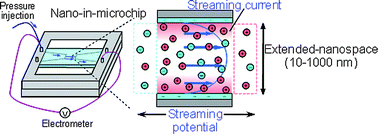The extended-nanospace, a space on the scale of 101–103 nm, is mostly unexplored due to the lack of sufficient experimental technology. Recently, the research of liquid properties in the extended-nanospace has gathered much interest, because the behavior of water molecules in this space is between that of liquid-like bulk phase water molecules and single molecules. Due to the large surface-to-volume ratio in the channel, the surface charge of the wall directly affects the water structure and ion distribution. The streaming potential/current measurement method, which is used to evaluate surface states directly, is an important and useful method to investigate the liquid properties. In this paper, we report a new method for measuring the streaming potential/current in size-controlled 2D extended-nanospace on glass substrate. Nano-in-microfluidic systems were fabricated on fused-silica glass substrates, and the liquid was air-driven using a pressure controller. An equivalent circuit of the detection system was designed to selectively detect the potential and current in the extended-nanospace. The basic measurement principle was verified using several different experiments. The absolute values obtained for the potential and current were also compared with the theoretical values for various channel sizes (360–1650 nm), and good agreement was observed for micrometre-scale channels. This technique will be valuable for the investigation of chemistry and fluidics in the extended-nanospace.

You have access to this article
 Please wait while we load your content...
Something went wrong. Try again?
Please wait while we load your content...
Something went wrong. Try again?


 Please wait while we load your content...
Please wait while we load your content...